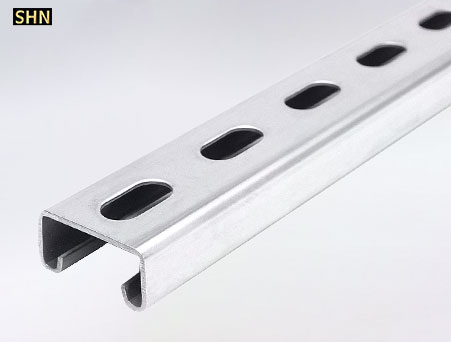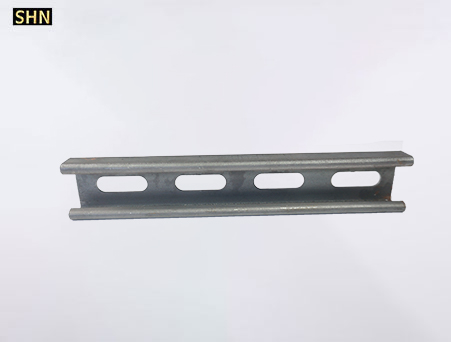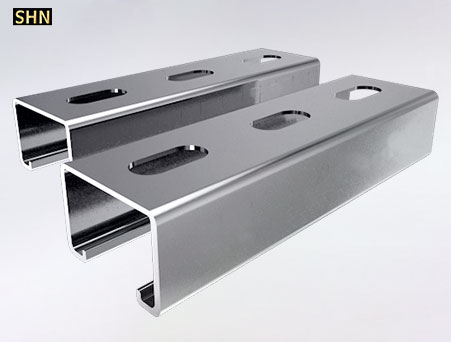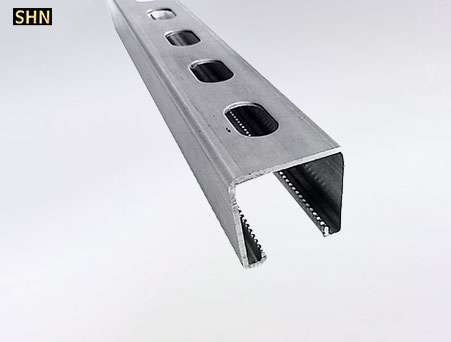+86 10 5248 4022
+86 18518927929

Mar. 15, 2024
Channel brackets are essential components in various construction and industrial applications, providing support and stability for piping, conduits, ducts, and other fixtures. When it comes to selecting the material for channel brackets, it's crucial to consider factors such as strength, durability, environmental conditions, and budget constraints. In this comprehensive guide, we'll delve into the intricacies of material selection for channel brackets to help you make informed decisions for your projects.



The material used in channel brackets significantly influences their structural integrity, load-bearing capacity, and resistance to environmental factors. Different materials offer varying levels of strength, corrosion resistance, and durability, making the selection process critical to ensure optimal performance and longevity.
Choosing the right material can prolong the lifespan of channel brackets by minimizing the risk of corrosion, deformation, and structural failure. Factors such as exposure to moisture, chemicals, temperature fluctuations, and mechanical stress can impact the durability of channel brackets, emphasizing the importance of selecting materials that can withstand these challenges.
Key considerations include the application requirements, environmental conditions, budget constraints, and aesthetic preferences. Evaluating factors such as material strength, corrosion resistance, cost-effectiveness, and availability can help you determine the most suitable material for your specific project needs.
Steel is a popular choice for channel brackets due to its high strength, rigidity, and versatility. However, its susceptibility to corrosion in certain environments may necessitate additional protective coatings or alternative materials for specific applications.
Aluminum offers excellent corrosion resistance and lightweight properties, making it ideal for applications requiring versatility and ease of installation. While it may not have the same strength as steel, aluminum's corrosion resistance and low maintenance requirements make it a preferred choice for outdoor and marine environments.
Stainless steel is renowned for its exceptional corrosion resistance and durability, making it well-suited for applications where exposure to moisture, chemicals, or extreme temperatures is a concern. Although stainless steel may come at a higher cost compared to other materials, its long-term performance and minimal maintenance requirements justify the investment for critical infrastructure projects.
The load-bearing capacity of channel brackets is a critical consideration, especially in applications where they support heavy loads or equipment. Steel, known for its high strength-to-weight ratio, is often the preferred choice for heavy-duty applications due to its ability to withstand significant loads without deformation or failure. However, aluminum and stainless steel can also be suitable alternatives depending on the specific requirements and environmental conditions.
Environmental factors such as moisture, chemicals, temperature extremes, and UV exposure can impact the performance and longevity of channel brackets. Stainless steel excels in harsh environments due to its corrosion resistance, making it ideal for outdoor, marine, and industrial applications. Aluminum is also suitable for outdoor use, particularly in areas prone to corrosion or saltwater exposure. Steel may require additional protective coatings or galvanization to enhance its resistance to corrosion in challenging environments.
While the initial cost of materials is a significant consideration, it's essential to evaluate the long-term cost-effectiveness of channel bracket materials. Stainless steel may have a higher upfront cost compared to steel or aluminum, but its durability and minimal maintenance requirements can result in cost savings over the lifespan of the project. Aluminum offers a balance between performance and affordability, making it a cost-effective choice for many applications. Ultimately, the total cost of ownership, including installation, maintenance, and potential replacements, should be factored into the decision-making process.

Determining the required strength of channel brackets involves assessing factors such as the weight of the supported load, the distance between brackets, and the anticipated stress levels. Steel is renowned for its high strength and rigidity, making it suitable for applications with heavy loads or structural demands. Aluminum and stainless steel offer adequate strength for most applications but may require thicker profiles or additional reinforcement in high-stress areas.
The choice of material for channel brackets should be tailored to the specific environmental conditions they will be exposed to. Stainless steel is highly resistant to corrosion, making it suitable for outdoor, marine, and chemical processing applications where exposure to moisture, chemicals, or corrosive substances is prevalent. Aluminum also offers good corrosion resistance, particularly in outdoor environments, although it may not be as durable as stainless steel in highly corrosive conditions. Steel may require protective coatings or galvanization to enhance its resistance to corrosion in harsh environments.
In addition to functional considerations, the aesthetic appearance of channel brackets may be a factor in certain applications, such as architectural or interior design projects. Stainless steel offers a sleek and modern appearance, making it a popular choice for high-end installations where aesthetics are important. Aluminum is available in various finishes and can be powder-coated or anodized to achieve specific color preferences. Steel may offer a more industrial or traditional look, depending on the surface finish and treatment applied.
When evaluating material quality for channel brackets, it's essential to consider industry standards and certifications that ensure compliance with performance and safety requirements. Look for materials that meet or exceed standards such as ASTM (American Society for Testing and Materials) for steel and aluminum alloys, or AISI (American Iron and Steel Institute) for stainless steel grades. Certification from recognized organizations such as ISO (International Organization for Standardization) or ANSI (American National Standards Institute) can provide further assurance of material quality and consistency.
Choosing a reputable strut channel manufacturer with a proven track record of delivering high-quality materials is crucial to ensure the reliability and consistency of channel brackets. Research suppliers' credentials, certifications, and customer reviews to gauge their reputation and reliability. Establishing a long-term partnership with a trusted supplier can provide access to expertise, technical support, and quality assurance processes that contribute to the overall success of your projects.
Conducting material testing and evaluation is essential to verify compliance with specified requirements and performance expectations. Common tests include tensile strength, yield strength, elongation, hardness, and corrosion resistance tests. Non-destructive testing methods such as ultrasonic testing or visual inspection can also be used to assess material quality and detect defects. Collaborating with materials engineers or third-party testing laboratories can provide valuable insights into material properties and performance characteristics, ensuring that channel brackets meet the necessary standards and specifications.
Outdoor installations require materials that can withstand exposure to moisture, UV radiation, temperature fluctuations, and other environmental factors. Stainless steel is highly resistant to corrosion and degradation, making it an excellent choice for outdoor applications where durability and longevity are paramount. Aluminum also offers good corrosion resistance and lightweight properties, making it suitable for outdoor installations that require ease of handling and installation. Steel may require additional protective coatings or galvanization to enhance its resistance to corrosion in outdoor environments.
In high-temperature environments such as industrial furnaces, exhaust systems, or HVAC ductwork, materials must withstand elevated temperatures without deformation or degradation. Stainless steel grades such as 304 and 316 offer excellent high-temperature resistance, making them suitable for applications where exposure to heat is a concern. Aluminum can also be used in moderate-temperature environments but may not be suitable for prolonged exposure to extreme heat. Specialized heat-resistant coatings or alloys may be required for steel channel brackets in high-temperature applications to prevent thermal expansion and structural failure.
In hygienic environments such as food processing plants, pharmaceutical facilities, or medical laboratories, materials must meet strict cleanliness and sanitation requirements to prevent contamination and ensure product safety. Stainless steel is the preferred choice for channel brackets in these applications due to its non-porous surface, corrosion resistance, and ease of cleaning. Aluminum can also be suitable for non-contact surfaces or areas where weight reduction is a priority. Steel may require special surface treatments or coatings to meet hygiene standards and prevent bacterial growth in sensitive environments.
Performing a thorough material analysis involves assessing factors such as mechanical properties, corrosion resistance, thermal stability, and environmental compatibility. Utilize available resources such as material datasheets, technical specifications, and testing data to compare material performance and suitability for specific applications. Consider consulting with materials engineers or specialists to interpret technical information and make informed decisions based on your project requirements.
Seeking advice from industry experts and engineers can provide valuable insights into material selection considerations, best practices, and potential challenges. Engage with professionals who have experience in your industry or application area to gain a deeper understanding of material performance, application requirements, and emerging trends. Collaborating with experts can help you navigate complex technical issues and identify innovative solutions to optimize your channel bracket designs.
When selecting channel bracket materials, it's essential to consider the long-term implications for maintenance, repairs, and replacements. Evaluate factors such as lifecycle costs, durability, and availability of spare parts to ensure sustainable performance over the project lifespan. Choose materials that offer reliability, ease of maintenance, and compatibility with future upgrades or modifications. Additionally, factor in potential downtime, safety risks, and operational disruptions associated with material failures or degradation.
Selecting the right material for channel brackets is a critical decision that requires careful consideration of various factors such as strength, durability, corrosion resistance, and cost-effectiveness. By evaluating application requirements, environmental conditions, and long-term implications, you can make informed decisions to ensure optimal performance and reliability for your projects.
Previous None
How to Secure Unistrut to Steel: A Comprehensive Guide
Mar. 15, 2024Unlocking the Potential: What is Channel Strut Used For?
Mar. 12, 2024Leave Message
Write down your urgent needs to get free samples, and to check our stocks

Copyright © SS&HN INDUSTRY GROUP Ltd. All Rights Reserved | Sitemap | Powered by 